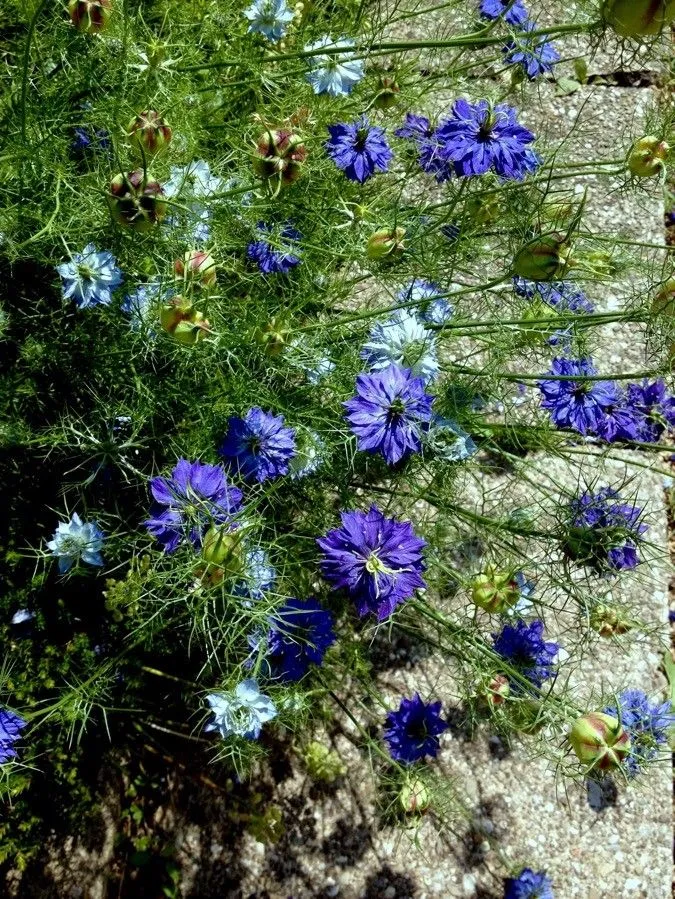
Author: L.
Bibliography: Sp. Pl.: 584 (1753)
Year: 1753
Status: accepted
Rank: species
Genus: Nigella
Vegetable: False
Observations: Macaronesia, Medit. to NW. Iran
Jack-in-the-green, known scientifically as Nigella damascena, is a captivating flowering plant belonging to the Ranunculaceae family. This enchanting species was first described by Linnaeus in Sp. Pl.: 584, back in 1753. Originating from the picturesque regions of Macaronesia and extending through the Mediterranean to Northwestern Iran, Nigella damascena thrives in these diverse landscapes, showcasing its adaptability and resilience.
Characterized by its finely divided, almost feathery foliage, the Jack-in-the-green plant casts a delicate, fern-like green presence in gardens. The striking flowers are its most enchanting feature, typically presenting a unique blue hue, though variations can range from white to pink and even purple. Each flower consists of five to ten petals and is encased in a lacy bract, giving an appearance reminiscent of a maid peeking through a veil – a visual that underscores its common name.
Floral enthusiasts prize Nigella damascena not only for its aesthetic appeal but also for its easy cultivation. It flourishes best in well-drained soils under full sun, yet it displays a robust tolerance to partial shade, making it a versatile addition to various garden settings. Often, it self-seeds, allowing gardens to sustain its charming presence year after year with minimal effort.
Beyond its beauty, Nigella damascena holds cultural significance. It has been cherished through the centuries both in traditional gardens and as a floral component in decorative arrangements. The dried seed pods, also known as “devil-in-a-bush,” are particularly favored in floral displays for their artistic, sculptural quality.
In summary, Jack-in-the-green is cherished for its graceful beauty, easy care, and historical presence in gardens across its native regions. Nigella damascena continues to be a treasured plant, celebrating the timeless charm of botanical elegance.
Spa: cabellos de venus, barbas-de-velho, damas-entre-verde
Deu: damaszener schwarzkümmel, damaszener schwarzkümmel, gretel im busch, jungfer im grünen
Lit: darželinė juodgrūdė
Eng: devil in the bush, jack-in-the-green, love in a mist, love-in-a-mist, wild fennel, damascus hellebore, devil-in-the-bush
Dan: jomfru i det grønne
Por: barbas-de-velho, cabelo-de-vênus, dama-entre-verdes, damas-entre-verde, nigela
Swe: jungfrun i det gröna
Hun: kerti kandilla
Fra: nigelle de damas
Nld: juffertje-in-het-groen
Cym: glas y niwl
En: Jack-in-the-green, Wild fennel, Love-in-a-mist, Devil in the bush, Devil-in-the-bush, Love in a mist, Damascus hellebore, Nigella
Af: Juffertijie-in-groen
Ar: شونيز دمشقي
Be: Чарнушка дамаская
Bg: Дамска челебитка
Ca: Flor d’aranya
Zh: 黑种草
Kw: Glas an niwl
Hr: Damaščanska crnjika
Cs: Černucha damašská
Da: Jomfru i det grønne
Nl: Juffertje-in-het-groen
Eo: Damaska nigelo
Et: Türgi mustköömen
Fi: Neidonkukka, Tarhaneito
Fr: Nigelle de Damas, Barbiche, Cheveux de Vénus, Barbe-de-capucin, Herbe de Capucin, Patte-d’araignée, Petite araignée
Gl: Luceiros
De: Damaszener Schwarzkümmel, Jungfer im Grünen, Damaszener Schwarzkümmel, Gretel im Busch, Gretchen-im-Busch, Gretel in der Heck, Gretel im Busch
El: Μελάνθιον το δαμασκηνόν
Hu: Borzaskata, Török kandilla, Török katicavirág, Kerti kandilla
It: Anigella, Damigella scapigliata, Fanciullacce, Damigella, Scapigilate
Ko: 니겔라
Lt: Darželinė juodgrūdė
Ml: നിഗല്ല ഡമാസ്കിന
Fa: نیگلا داماسکنا
Pl: Czarnuszka damasceńska
Pt: Var.miss jekill, Barbas-de-velho, Cabelo-de-vênus, Dama-entre-verdes, Damas-entre-verde, Nigela
Ru: Чернушка дамасская
Sr: Мaчкoв брк
Sk: Černuška damascénska
Es: Cabellos de Venus, Barbas-de-velho, Damas-entre-verde, Ajenuz de jardín, Araña, Arañuela, Neguilla de Damasco
Sv: Jungfrun i det gröna
Zh-tw: 黑種草
Tr: Şam çörek otu
Uk: Чорнушка дамаська
Cy: Glas y niwl
Taken May 31, 2020 by Stantin Stantino (cc-by-sa)
Taken May 31, 2020 by Stantin Stantino (cc-by-sa)
Taken Jun 6, 2021 by Pierre GIRARD (cc-by-sa)
Taken Jun 6, 2021 by Pierre GIRARD (cc-by-sa)
Taken Jun 6, 2021 by Pierre GIRARD (cc-by-sa)
© copyright of the Board of Trustees of the Royal Botanic Gardens, Kew.
© copyright of the Board of Trustees of the Royal Botanic Gardens, Kew.
© copyright of the Board of Trustees of the Royal Botanic Gardens, Kew.
Taken Aug 7, 2020 by Dieter Wagner (cc-by-sa)
Taken Aug 7, 2020 by Dieter Wagner (cc-by-sa)
Taken Aug 3, 2021 by Pour Demos (cc-by-sa)
Taken May 30, 2018 by Dieter Wagner (cc-by-sa)
Taken May 30, 2018 by Dieter Wagner (cc-by-sa)
Taken May 31, 2020 by Rémi Sauvan (cc-by-sa)
Taken Sep 16, 2022 by Kai Best (cc-by-sa)
Taken Dec 9, 2020 by john pulitzer (cc-by-sa)
Taken Jan 2, 2020 by Murdoch Smith (cc-by-sa)
Taken Jun 16, 2019 by Dieter Wagner (cc-by-sa)
Taken Jul 30, 2021 by Mariusz Staniszewski (cc-by-sa)
Taken Sep 16, 2022 by Kai Best (cc-by-sa)
Taken Oct 27, 2019 by Nastrond (cc-by-sa)
Taken Oct 9, 2021 by Krassakis Jorgos (cc-by-sa)
Taken Jun 6, 2021 by Pierre GIRARD (cc-by-sa)
Taken Jul 27, 2019 by Ferrero Lorenzo (cc-by-sa)
Taken May 15, 2019 by Chris Georges (cc-by-sa)
Taken Jun 10, 2021 by Tifani Voelcker (cc-by-sa)
Taken Jul 24, 2020 by Pour Demos (cc-by-sa)
Taken May 10, 2018 by Thierry Bickard (cc-by-sa)
Taken Jul 30, 2020 by dragongid (cc-by-sa)
Taken Jun 20, 2021 by Kieran Brennan (cc-by-sa)
Taken Aug 4, 2022 by Jim Knopf (cc-by-sa)
Taken Aug 28, 2022 by Häxa Noita (cc-by-sa)
Taken Jul 26, 2020 by Dieter Wagner (cc-by-sa)
Growth habit: Forb/herb
Bloom months: [‘jun’, ‘jul’]
Family: Myrtaceae Author: (F.Muell.) K.D.Hill & L.A.S.Johnson Bibliography: Telopea 6: 402 (1995) Year: 1995 Status:…
Family: Rubiaceae Author: Pierre ex A.Froehner Bibliography: Notizbl. Bot. Gart. Berlin-Dahlem 1: 237 (1897) Year:…
Family: Sapindaceae Author: Koidz. Bibliography: J. Coll. Sci. Imp. Univ. Tokyo 32(1): 38 (1911) Year:…
Family: Asteraceae Author: A.Gray Bibliography: Pacif. Railr. Rep.: 107 (1857) Year: 1857 Status: accepted Rank:…
Family: Fabaceae Author: Medik. Bibliography: Vorles. Churpfälz. Phys.-Ökon. Ges. 2: 398 (1787) Year: 1787 Status:…
Family: Aspleniaceae Author: (Cav.) Alston Bibliography: Bull. Misc. Inform. Kew 1932: 309 (1932) Year: 1932…